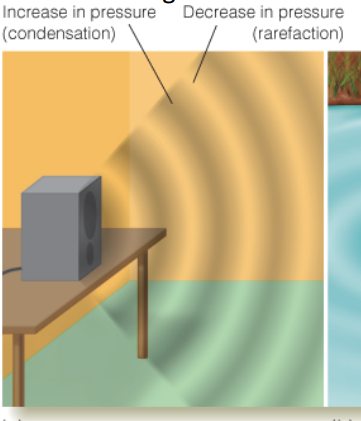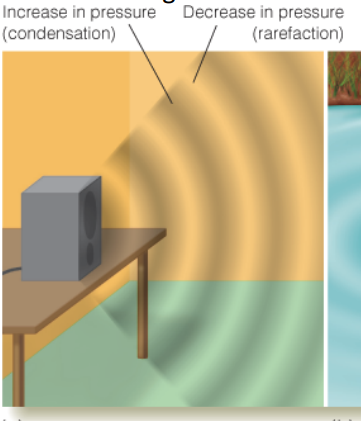Vocabulary Terms for Chapter 11
1/42
Earn XP
Description and Tags
Chapter 11 - "Hearing" vocab term study, based off of the Lecture Notes for this chapter.
Name | Mastery | Learn | Test | Matching | Spaced |
|---|
No study sessions yet.
43 Terms
Sound Stimulus
Occurs when the movements or vibrations of an object cause pressure changes in air, water, or any other elastic medium that can transmit vibrations.
Physical Definition of Sound
Pressure changes in the air or other mediums.
Perceptual Definition of Sound
The experience we have when we hear.
Condensation
When there is an increase in the pressure of air molecules being pushed together.

Rarefaction
When there is a decrease in the pressure of air molecules being pulled apart from each other.

Sound Wave
The pattern of air pressure changes, which travels through the air at 340 meters per second.
Pure Tone
Occurs when changes in air pressure occur in a pattern described by a mathematical function called a sine wave.
Sine Wave
The mathematical function that describes the patterns of the changes in air pressure.
Frequency
The number of cycles per second that the pressure changes repeat.
Hertz
1 Hertz (Hz) is 1 cycle per second.
FACTS:
Higher frequencies are usually associated with higher pitches.
Humans can perceive frequencies ranging from about 20 Hz to about 20,000 Hz.
Amplitude
The size of the pressure change. Measured in decibels (dB).
Loudness
Involves differences in the perceived magnitude of a sound. Illustrated by the difference between a whisper & a shout. The perceived intensity of a sound that ranges from “just audible” to “very loud”.
Threshold
The smallest amount of sound energy that can just barely be detected.
Audibility Curve
A curve that indicates the sound pressure level (dB SPL) at the threshold for frequencies (Hz) across the audible spectrum.
Auditory Response Area
The psychophysically measured area that defines the frequencies & sound pressure levels over which hearing functions. This area extends between the audibility curve and the curve for the threshold of feeling. It shows the range of response for human audition.
Equal Loudness Curves
Exemplifies the relationship between loudness & frequency. It is a curve that indicates the sound levels that create the same perception of loudness at different frequencies.
Pitch
Involves differences in the low to high quality of sounds. Illustrated by what we hear playing notes from left to right on a piano keyboard. The perceptual quality of sound, ranging from low to high, is most closely associated with the frequency of a tone. PSYCHOLOGICAL PROPERTY OF SOUND.
Timbre
The quality that distinguishes between 2 tones that sound different even though they have the same loudness, pitch, & duration. Differences in timbre are illustrated by the different sounds made by different musical instruments, even when playing the same way.
FROM PRESSURE CHANGES TO ELECTRICITY - THE 3 TASKS ACCOMPLISHED BY THE AUDITORY SYSTEM DURING ITS JOURNEY:
First, it delivers the sound stimulus to the receptors.
Second, it transduces this stimulus from pressure changes into electrical signals.
Third, it process these electrical signals so they can indicate qualities of the sound source, such as pitch, loudness, timbre, & location.
Outer Ear
Where sound waves first pass through. Consists of the pinnae, the auditory canal, & the tympanic membrane (eardrum).
Pinnae
The structures that stick out from the sides of the head. Helps us determine the location of sounds.
Auditory Canal
A tubelike recess about 3 cm long in adults. Protects the delicate structures of the tympanic membrane & the middle ear from the outside world. Enhances the intensities of some sounds by means of the physical principle of resonance.
Resonance
A mechanism that enhances the intensity of certain frequencies because of the reflection of sound waves in a closed tube.
Tympanic Membrane (Eardrum)
A membrane at the end of the auditory canal that vibrates in response to vibrations of the air & transmits these vibrations to the ossicles in the middle ear.
Middle Ear
An air-filled small cavity, about 2 cubic cm in volume, that separates the outer & inner ears. Contains the ossicles.
Ossicles
3 small bones in the middle ear that transmit vibrations from the outer to the inner ear.
Malleus (the Hammer)
Moves due to the vibration of the tympanic membrane & transmits these vibrations to the incus.
Incus (the Anvil)
Transmits vibrations from the malleus to the stapes.
Stapes (the Stirrup)
Receives vibrations from the incus & transmits these vibrations to the inner ear via the oval window of the cochlea.
Oval Window
A small, membrane-covered hole in the cochlea that receives vibrations from the stapes.
Inner Ear
The innermost division of the ear, containing the cochlea & the receptors for hearing. The main structure is the cochlea. The cochlea.
Cochlea
Fluid-filled snail-like structure 935 mm long) set into vibration by the stapes. Divided into the Scala Vestibuli (upper half) & Scala Tympani (lower half) by the cochlear partition.
Cochlear Partition
A partition in the cochlea, extending almost its full length, that separates the scala tympani & the scala vestibuli.
Organ of Corti
Major structure of the cochlear partition, containing the basilar membrane, the tectorial membrane, & the receptors for hearing (inner & outer hair cells).
Basilar Membrane
Stretches the length of the cochlea & vibrates in response to sound & supports the organ of Corti.
Tectorial Membrane
Extends directly over the hair cells.
Hair Cells
Neurons in the cochlea that contain small hairs, or cilia, that are displaced by vibration of the basilar membrane & fluids inside the inner ear.
2 KINDS OF HAIR CELLS
Inner & Outer.
Inner Hair Cells
Auditory receptor cells in the inner ear that are primarily responsible for auditory transduction & the perception of pitch.
Outer Hair Cells
Auditory receptor cells in the inner ear that amplify the response of inner hair cells by amplifying the vibration of the basilar membrane.
TRANSDUCTION PROCESS (from vibration to electrical signal):
Cilia (small hairs) bend in response to movement of organ of Corti & the tectorial membrane.
Movement in 1 direction opens ion channels.
Movement in the other direction closes the channels (this causes bursts of electrical signals).
THE PATHWAY OF FIBERS & SIGNALS TO THE BRAIN
Begins with the Cochlear Nucleus
Continues to the Superior Olivary Nucleus in the brain stem
The Inferior Colliculus in the midbrain
And then the Medial Geniculate Nucleus in the thalamus
From there, the fibers continue to the Primary Auditory Cortex (or the Auditory Receiving Area, A1) in the temporal lobe of the cortex.